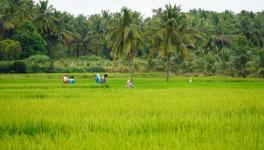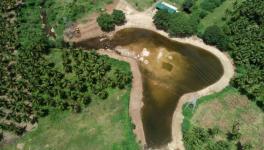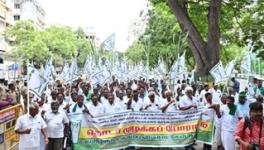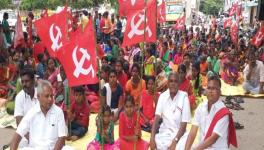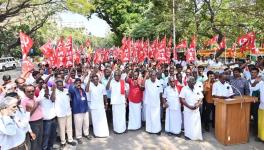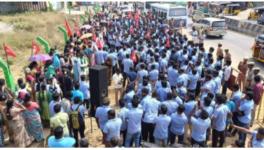TN: Shadow of Solar Project on Grazing Land Keeps Tirunelveli Village on its Toes
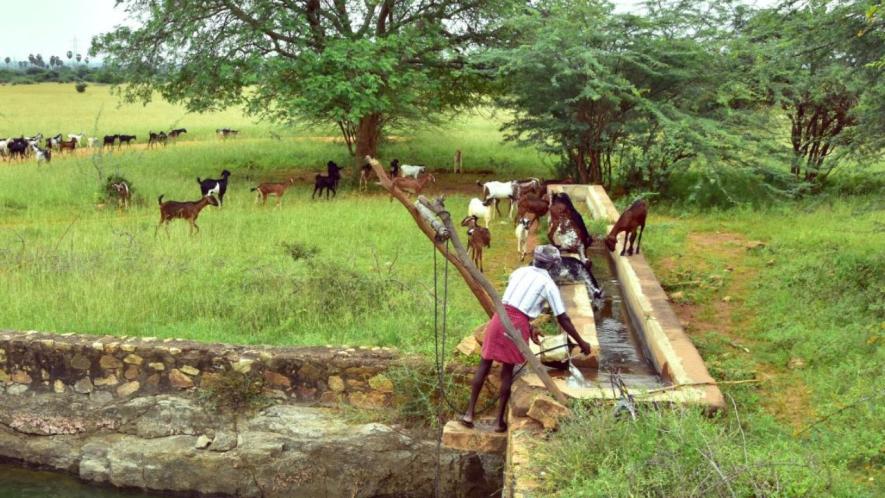
A system for watering cattle (Photo sourced by Vignesh A, 101Reporters).
Tirunelveli, Tamil Nadu: Located 22 km north of Tirunelveli, the vast green expanse of Alavanthankulam in Pallikottai panchayat is a haven for farm animals. “Such extensive grazing land with community rights cannot be found anywhere else in Tamil Nadu,” claims M Viyagappan (37), the village community head of Devendrakula Vellalars, a Scheduled Caste.
“This land was the reason for low migration for over three generations. We Dalits have community rights for it, but about 20,000 families belonging to all castes from over 10 villages depend on it. Nearly one lakh farm animals, predominantly cows and sheep, are grazed here. This is why our protest gets a huge support from neighbouring villages,” he says.
The protest that Viyagappan refers to is in response to a proposal to build a solar-based project at Alavanthankulam, a village with a total population of over 3,000 where Devendrakula Vellalars are in majority.
The protest began when the state government signed a memorandum of understanding with Tata Power in 2022 to establish a greenfield solar cell and module manufacturing plant in Tirunelveli district. The Tata Group will invest Rs 3,000 crore on the 4GW solar cell and 4GW solar module plant over a period of 16 months, according to an official press statement released by Tata Power in July 2022. Since the acquisition is not over, there is uncertainty about when the plant work will begin.
The State Industries Promotion Corporation of Tamilnadu Ltd (SIPCOT) began land acquisition in December 2021, but so far part of the land owned by private individuals only has been acquired. The notification issued by the district Collector for land acquisition states the survey numbers of the grazing land. The only thing not explicitly mentioned was that the land will be given to Tata Power. As per the copies of the government documents accessed by 101Reporters, 342.18 acres of grazing land will be part of the total 1,664.73 acres required for the project.
With grazing land inclusion becoming an issue, Madurai-based civil rights activist C Anand Raj petitioned Manur tehsildar on September 7 last year, but without a positive response. Subsequently, on September 29, he approached the Madurai Bench of Madras High Court, which dismissed the public interest litigation in October and ordered the Tirunelveli Collector to dispose of the representation that Raj had made to the district authorities.
In his response dated January 3 this year, Collector KP Karthikeyan stated that the land in question was not a panchami land as per the report of the assistant director (land survey). The response stated that only 342.18 acres out of the total 406.97 acres would be acquired and the remaining 64.79 acres would be enough for grazing.
The reply stated it was a barren land with no agricultural activity happening for over 30 years. This inadvertently endorsed the villagers’ claim of grazing land.
Panchami is basically a categorisation of land ownership and not land usage. In terms of land usage, the government records categorise it as a punjai land (where rainfed agriculture is possible). This again implies that the villagers did not use it for cultivation because they needed it for grazing.
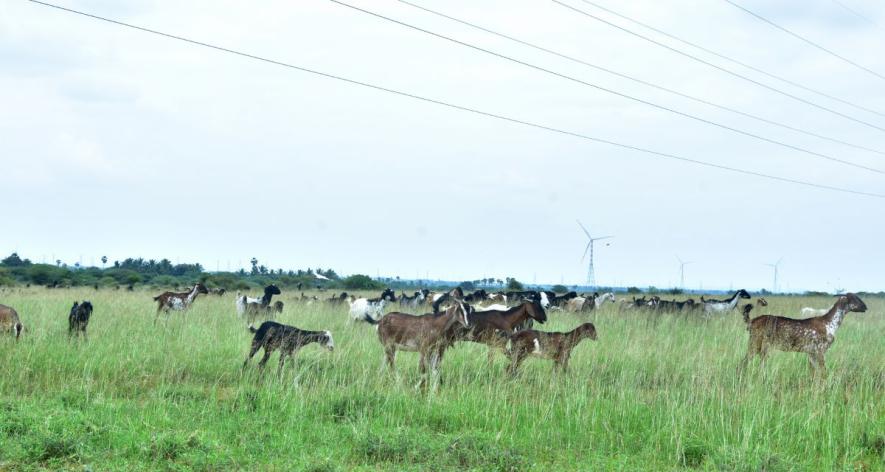
More than 20,000 goats, sheep, and cows in Alavanthankulam (Photo sourced by Vignesh A, 101Reporters)
Panchami land or not?
It was in the 1890s that the erstwhile British rulers allotted panchami lands to the Dalits of Tamil Nadu under the Depressed Classes Land Act. Such lands were barred from re-classification, and it was illegal for non-Dalits to buy them. The Act mandated that the transaction of these lands could take place only between Dalits, and that too only for agricultural purposes.
Though various social organisations claim that over 12 lakh acres of waste and unused lands had been distributed as panchami lands with individual and community rights, the land records had been lost over the decades, and the lands with individual ownership ultimately reached the hands of non-Dalits from dominant castes.
What makes the land of Alavanthankulam a rare exception is the panchami land here has not been sold or diverted, because the land has community ownership.
Devendrakula Vellalars of Alavanthankulam claim that they have grazing rights over 406.97 acres under Pirancheri revenue village for over a century. The panchami land was allotted to them in 1897. The land document with the state revenue department also states that the land is owned by 64 ar arijana uzhavar samudhayam, which means ‘64 Ar Harijan farming community’.
“The British-era land document from 1903 available with the villagers clearly states that the land was allotted to the Dalits in 1897. The district administration can do some research on whether this is a panchami land or not, but they cannot outrightly deny it is not so,” says M Vargheesh Antony (43), Alavanthankulam resident and an organiser of the Republic Day protest.
Raj tells 101Reporters that circumstantial evidence shows the land is most probably a panchami land. “There is a document to show... Also, the Britishers allotted panchami lands to the Dalits only in the 1890s.”
“Even after Independence, the documents of the Tamil Nadu government states that the 64 ar arijana uzhavar samudhayam has a collective ownership over the land. If it is not a panchami land, how did the word arijana enter into the document,” asks Raj, who plans to appeal the High Court judgment in the Supreme Court.
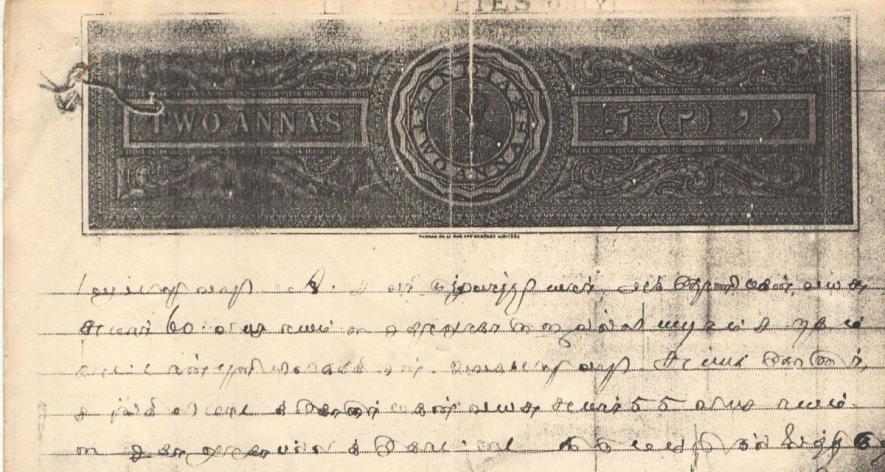
This document written in 1903 shows that the land under dispute was given to the Dalits in 1897 (Photo sourced by Vignesh A, 101Reporters).
Livelihood at stake
C Anthonyammal (67), a widow from Alavanthankulam, has five goats and two cows. "I have six children and all of them live separately. I could sustain myself due to the grazing land. If it is lost, my regular income will be gone. All I will be left with will be Rs 1,000 the government provides [under Kalaignar Magalir Urimai Thogai]. How will that be enough? I am thinking of moving to an old-age home if things become tough," she says.
Kulanthai Teresa Rani (52), another widow, cannot work in farms or under wage guarantee scheme due to health complications. "I live alone, but have 10 goats. This income helps me to meet medical expenses... If the government acquires our land, we may be forced to rear livestock on private lands, which could lead to unnecessary issues with land owners."
D Alangaram (55), a shepherd from Alavanthankulam, claims that he looks after over 2,000 goats of Alavanthankulam and Nellai Thiruthu, including 10 of his own. "The owners make an annual payment of Rs 120 per goat."
As per his estimate, the total sheep population in these villages would cross 5,000. "The remaining 64 acres will not be enough to feed our livestock," he states.
Viyagappan says almost every household at Alavanthankulam owns five to 10 goats. "We have even employed a person to rear the 2,000-plus sheep in the village. Each owner will pay him Rs 110 per sheep per annum,” he says, pointing to the agrarian nature of his community.
“Basically what the government says is that they will provide employment to 2,000 people by destroying the livelihood of 20,000. Since the grazing land is not owned by individuals, the government does not have to give monetary compensation for acquisition,” says Antony. Moreover, there is no guarantee that the people the plant employs will be from Alavanthankulam.
Viyagappan owns 15 cows and 20 sheep, and claims that he could not have raised his three children without the land. “We are not against the plant. What we demand is not to set it up in our grazing land,” he adds.
This Republic Day, over 3,000 families and commercial establishments at Alavanthankulam and its neighbourhood staged a black flag protest against land acquisition. The same day, Alavanthankulam announced a boycott of the upcoming Lok Sabha elections. According to sources, following the protest, Manur Police have registered a case against about 50 villagers, including Viyagappan, for unlawful assembly and creating public nuisance.
Before that, on August 15 and October 2 last year, the Pallikottai village panchayat’s gram sabha passed two resolutions against grazing land acquisition. However, the government is in no mood to relent.
Efforts to reach Revathi Chandrasekaran, Special District Revenue Officer (Land Acquisition), Tirunelveli, did not solicit any response. Special Tehsildar (Land Acquisition) S Venkataraman, the second highest officer dealing with land acquisition issues in the district, tells 101Reporters that he has no idea about the Alavanthankulam issue.
Antony says he is yet to get a reply to an email he sent a few months ago to a Tata Power representative seeking stopping of acquisition. 101Reporters also sought to know if a Tata Power plant was the subject of a poll boycott at Alavanthankulam and how the company plans to address the concerns of the locals.
Renewability vs sustainability
Professor Beena PL of the Centre for Development Studies, Thiruvananthapuram, whose areas of specialisation include Developmental Implications, tells 101Reporters that there is no systemic framework for mitigation and adaptation for the economic implications as much as the push for renewable energy production.
“The same is the case with special economic zones… The number of cattle in a region will have something to do with the quality of soil, sustaining agriculture etc. Grazing land would play a role in maintaining the sustainability of agriculture there,” she says.
While hailing Tamil Nadu as one of the leading states in adopting and producing renewable energy, Beena insists on doing a cost-benefit analysis (comparison of existing employment and income generation with the potential employment and income generation through proposed projects).
Undoubtedly, income earned through milk and profit from cattle sale will go down drastically if farmers lose their grazing land. Villages around Pallikottai and Pirancheri have registered cattle rearers associations, in which hundreds of families are members. These families may have to search for agricultural labour, or migrate for livelihood.
On average, a family earns Rs 7,000 to 8,000 per month through livestock. Every six months or a year, they sell cows and goats. Sales amount can run into a few lakh for those with a considerable flock of sheep.
(Vignesh A is a Tamil Nadu-based freelance journalist and a member of 101Reporters, a pan-India network of grassroots reporters.)
Get the latest reports & analysis with people's perspective on Protests, movements & deep analytical videos, discussions of the current affairs in your Telegram app. Subscribe to NewsClick's Telegram channel & get Real-Time updates on stories, as they get published on our website.









